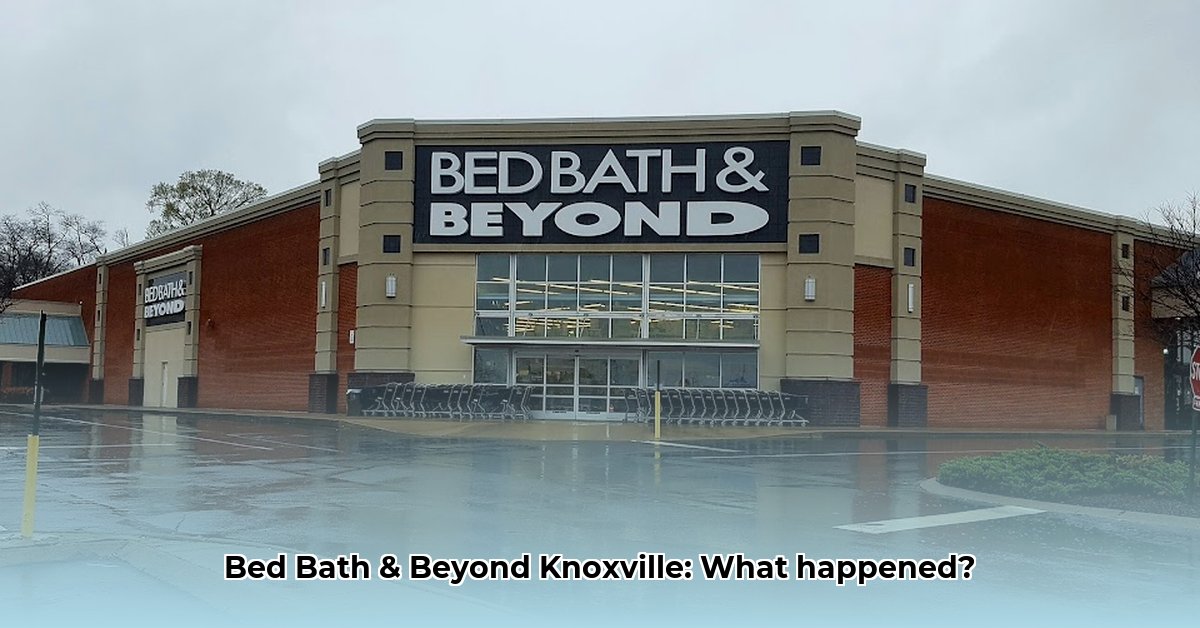
Bed Bath & Beyond Knoxville TN: The Closing and Its Broader Implications
The recent closure of the Bed Bath & Beyond store in Knoxville, Tennessee, marks another step in the company's extensive restructuring efforts. This isn't an isolated incident but reflects a larger struggle faced by the retailer, impacting employees, consumers, and the local economy. Understanding the reasons behind this closure requires examining Bed Bath & Beyond's broader financial challenges and strategic response.
This closure is a consequence of the company's ongoing struggle to maintain market share in a rapidly evolving retail landscape. The rise of e-commerce giants and the increasing popularity of smaller, more specialized home goods retailers have significantly impacted Bed Bath & Beyond's sales and profitability. The company hopes its restructuring plan, involving strategic store closures and a renewed focus on online sales, will improve its financial position. However, the success of this strategy remains uncertain.
Three Pivotal Points:
- The Knoxville closure is part of a larger company-wide restructuring aimed at improving profitability and addressing declining sales.
- The closure will directly impact employees, requiring job searches and potential retraining, while also affecting the local Knoxville economy through loss of jobs and tax revenue.
- Bed Bath & Beyond's long-term prospects are uncertain, contingent on the success of its restructuring efforts and the company’s ability to adapt to the changing retail environment.
The Impact on Knoxville and Beyond
The closure of the Knoxville store has several immediate and long-term consequences. The most immediate is the loss of jobs for employees, forcing them to seek new employment and potentially requiring retraining. This loss of employment ripples through Knoxville’s local economy, impacting not only the employees themselves but also the surrounding businesses that benefited from the store’s foot traffic. The reduced tax revenue from the store closure further strains local government finances. The empty storefront also presents challenges to the local property market, requiring landlords to find new, suitable tenants.
How will consumers adapt? The closing presents an immediate inconvenience for shoppers who relied on the store for home goods. They'll need to find alternative options, either by switching to online shopping or finding new physical stores. This shift in consumer behavior could further impact the local economy.
Bed Bath & Beyond's Action Plan: A Gamble for Survival?
Bed Bath & Beyond’s response is a multi-pronged approach aimed at streamlining operations and enhancing its online presence. Key elements include:
- Targeted Store Closures: The company is strategically closing underperforming stores to minimize costs and focus resources on more profitable locations.
- E-commerce Investment: A significant investment is directed towards improving the online shopping experience to enhance its appeal to the growing online customer base.
- Inventory Optimization: The company is working towards improving its inventory management to reduce waste and optimize its supply chain.
- Strategic Partnerships: Exploring collaborations with other businesses to expand product offerings or tap into new markets.
Stakeholder Analysis: Assessing the Impact
The impact of the closures varies across different stakeholder groups.
| Stakeholder Group | Immediate Impact | Longer-Term Outlook |
|---|---|---|
| Bed Bath & Beyond Company | Reduced operating costs; potential for improved profits | Uncertain; success hinges on the restructuring plan's success |
| Knoxville Employees | Job loss, requiring job searching and potentially retraining | Need to find new positions; career path adjustments |
| Knoxville Shoppers | Loss of a convenient shopping option; need to find substitutes | Shift to online shopping or alternate local retailers |
| Knoxville Local Economy | Reduced tax revenue, potential job losses in related businesses | Adapting to changing retail landscapes; potential for new businesses |
Risk Assessment and Mitigation Strategies
The restructuring plan carries inherent risks:
- Financial Instability: The company's continued financial viability is paramount; insufficient funding could derail the plan.
- Inventory Management: Inefficient inventory management could lead to losses and further financial strain.
- Public Backlash: Negative public perception could damage the brand reputation and hinder efforts to regain market share.
Mitigation strategies would involve securing necessary funding, investing in advanced inventory management systems, and actively engaging in transparent communication with customers. These strategies may help mitigate the risks and increase chances of success.
Conclusion: An Uncertain Future
The Bed Bath & Beyond Knoxville store closure symbolizes the broader challenges faced by traditional retailers. The company's future hinges on the successful execution of its restructuring strategy and its ability to adapt to the changing retail landscape. The impact on Knoxville, and similar communities affected by these closures, will unfold over time, illustrating the complex interplay between corporate restructuring and local economic conditions. While the company aims to streamline operations and boost profitability, the long-term success of these measures remains to be seen.